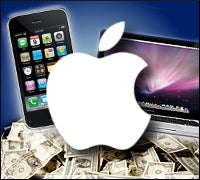 |
Some analysts are suggesting the recession is over, but for Apple (NASDAQ: AAPL), the recession might as well have never started. The company on Monday reported record quarterly revenues and profits as it enjoyed strong sales in Macs and iPhones.
Apple announced fiscal fourth-quarter GAAP income of $1.67 billion, or $1.82 a share, on revenue of $9.87 billion for the quarter ended Sept. 26, easily surpassing estimates of analysts surveyed by Thomson Reuters, who had forecast the company to earn $1.42 a share on revenue of $9.2 billion.
Apple is also one of the few companies that has continued to enjoy top-line growth during the financial downturn while increasing profitability. The company earned $1.14 billion, or $1.26 a share, on $7.9 billion in sales in the same quarter last year, representing 46 percent growth in earnings year-over-year and a 25 percent increase in revenue.
Those numbers could have been even better. Because Apple recognizes revenue for the iPhone and Apple TV over the life of the products, rather than all of it when the product is sold, its adjusted revenue and income are in fact much lower. Non-GAAP revenue would have been $12.25 billion and non-GAAP income would have been $2.85 billion.
That approach may change in the near future, however. During a conference call with investors, CFO Peter Oppenheimer said that on Sept. 23, the company had been granted approval by the Financial Accounting Standards Board (FASB) to change its accounting rules, so it can realize most of the revenue from iPhone and Apple TV sales immediately.
Still, Oppenheimer added the company isn’t sure when it will do that. Apple has until the first quarter of fiscal 2011, which would be five quarters from now, to make the change.
“We don’t know at this time the specific amount of revenue [that will be realized], but do believe a substantial portion of revenue will be recognized at the time,” he told analysts on the call. “We are currently assessing the impact on the accounting and reporting processes so we are uncertain of timing when we will adopt this. So I have nothing more specific to offer at this time.”
Selling like mad
Apple sold 3.05 million Macintosh computers during the quarter, its best quarter ever and a 17 percent unit increase over the same quarter last year. Macintosh has outgrown the rest of the market for 19 of the past 20 quarters, Oppenheimer said.
With the quarter including back-to-school sales, Apple scored some big wins in the educational sector, including 50,000 units to the state of Maine.
Oppenheimer also said that Snow Leopard, AKA Mac OS X 10.6, is selling at twice the rate as its predecessor, Leopard.
iPhones fared even better, with Apple selling 7.4 million of the smartphones during the quarter — a 7 percent unit growth over the same quarter last year. Sell-through increased 38 percent year-over-year because Apple increased its inventory in the retail channel by two million units, Oppenheimer said.
The company is also aiming to dramatically expand its iPhone business. At the end of this month, the company will launch the iPhone in China, the world’s largest market, with 1,000 retail outlets and more to come.
During its fourth quarter, Apple also sold 10.2 million iPods, an 8 percent unit decline from the 2008 quarter. The company launched new iPods in early September, an event that also featured the return of CEO Steve Jobs to the public eye after an absence due to health problems.
Its retail business continues to do well. The company opened 15 new stores for a total of 273, with average revenue per store of $7.1 million. That’s down a little from last year, when they averaged $7.6 million. But total retail revenue in the quarter was $1.87 billion, an increase of 8 percent over the $1.72 billion in its stores last year.
New products ahead for Apple?
Apple is sitting pretty right now, with cash and securities of $34 billion. Cash flow for the quarter was $3.1 billion, and that was after making a huge NAND flash purchase from Toshiba. Oppenheimer did not elaborate on the reason for the purchase.
The company said it expects to see next quarter’s revenue ranging from $11.3 billion to $11.6 billion, with earnings in the range of $1.70 to $1.78 per share.
Margins will average 34 percent, a slight dip for the company.
Oppenheimer gave several reasons for why gross margin could decline: For one thing, they could be attributable to new products with lower gross margins than predecessors — thought didn’t say what the new products would be.
He also pointed to a seasonally higher mix of iPods, which don’t have great margins; a trailing off in sales for Snow Leopard, higher component costs and significantly more costs for air freight to get product to retail for the holidays.
Updated to include information and quotes from the conference call.


